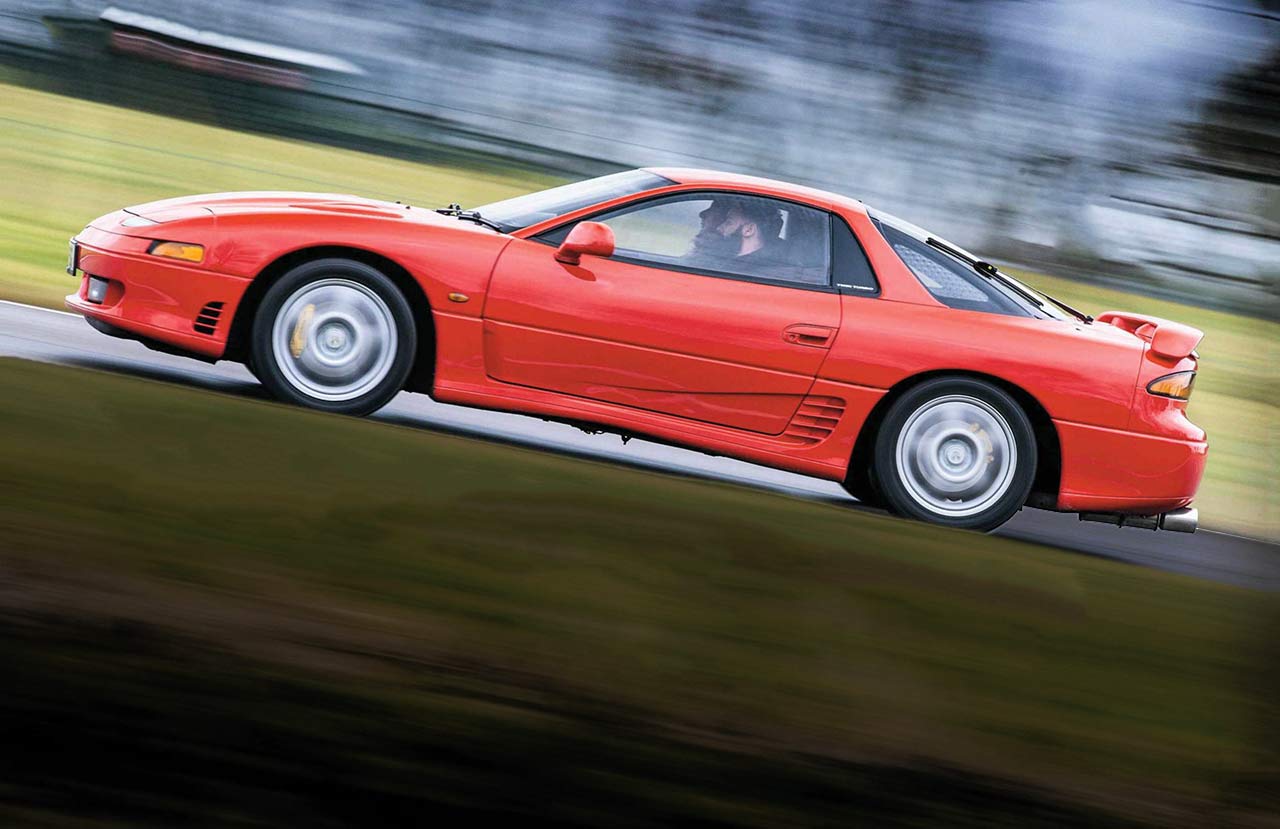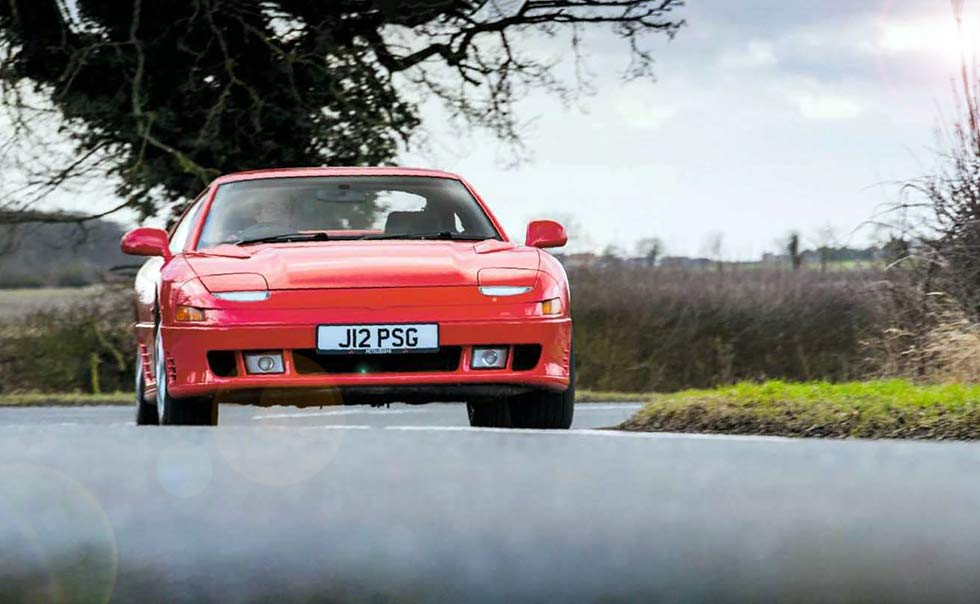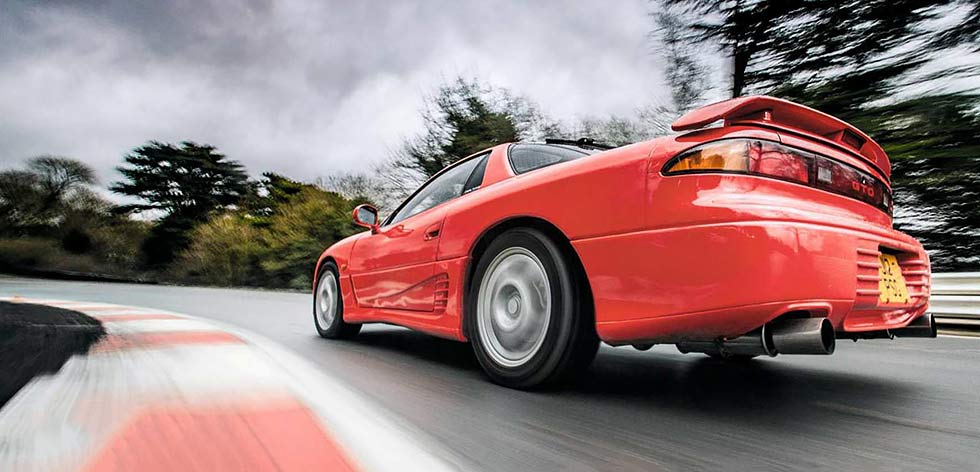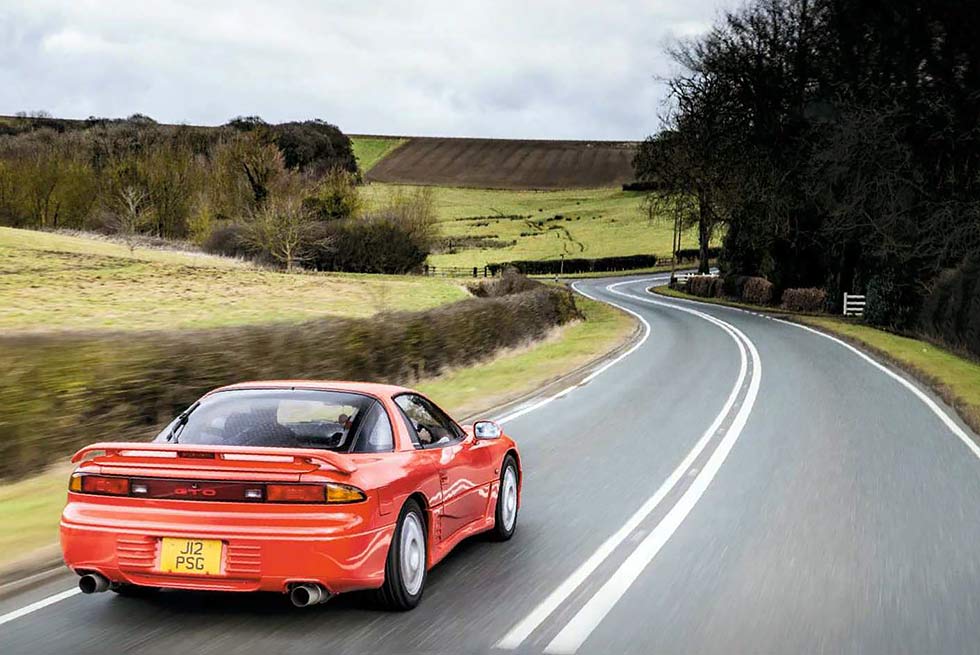
Toys for the boys Why the Mitsubishi 3000GT deserves to survive. This gadget-filled coupé always had a lot of tech but is that all it had to offer? We take one to Cadwell Park to find out. Words Martin Domoney. Photography Adam Shorrock.
MITSUBISHI 3000GTThis supercar-fast technical marvel is disappearing as fast as it accelerates – it’s time to make your move
ONLY 262 LEFT / ENDANGERED SPECIES
The early 1990s was an exciting and progressive time for automotive development, not least in Japan. In the midst of the usual humdrum hatchbacks and people carriers being churned out by the big players in the country’s motor industry, engineers were flexing their technological muscles and unleashing some pretty spangly and tricksy features on to the market, especially in the fast coupé sector in which many of the big marques were keen to parade their know-how.

Mitsubishi’s boffins were determined to play a part in that process. In answer to Toyota’s Supra, Mazda’s RX-7 and Nissan’s 300ZX, the Mitsubishi GTO (3000GT in the UK) arrived in 1991, bringing a tsunami of futuristic performance enhancing gadgetry – derivatives of which can still be seen on the most exclusive Italian exotica of 2018.
The range-topping GTO packed a 3.0-litre quad-cam V6, with a turbo hanging off each bank. In domestic tune, the buttery-smooth engine delivered 276bhp (oddly, the 3000GT got nearly 20 extra) through a Getrag five-speed manual box and a compact transfer box. A three-piece prop sent the power to a limited-slip diff. There’s a lot going on under a GT, and that’s before taking into account the four-wheel steering and electronically controlled dampers. This space-age GT has a pop-up spoiler and deployable front splitter, beaten only by the Porsche 959 and VW Corrado for first-use honours.
While such toys are what make the big Mitsu what it is, the passage of time has exacted a cruel toll on some examples of the 3000GT. As depreciation bit, many fell into the hands of those who fancied champagne power and looks on a lemonade budget. The Fast and the Furious generation quickly cottoned on to the fact that the addition of an eBay boost controller and a few other choice mods could bump up the power very easily. The 3000GT thus became one of the cheapest ways into the 300+bhp club. Inevitably, the relative complexity of the cars and the lack of affordable OEM parts meant that more and more of these far-east beasts actually went west, ending up rather the worse for wear, and eventually being advertised as ‘spares or repairs’ for not much money. Refreshingly, this Japanese heavyweight now has quite the enthusiast following.

Members of owners’ clubs – such as GTOUK – are deciphering the systems that would’ve given Bill Gates a headache back in ’1991, and they are happy to share the knowledge with anyone who is as keen as they are to bring this svelte GT back from the brink. Add in a savvy and well-stocked aftermarket parts supplier and the future is looking bright for the 3000; and for anyone interested in giving a previously unloved example a home.
First impressions count for a lot, and it’s obvious that Mitsubishi knew what it was doing with this car’s styling. It’s a fine line between supercar and 3000GT cruiser, and the 3000GT’s aesthetics definitely sit in the former camp.
The wide, vented flanks are a surefire cue to make school-kids shout ‘nice Ferrari, mister!’ An event the owner of this car tells me isn’t uncommon. The bright-red paint probably doesn’t help with this first-world problem. Cutting deeply into the rearmost roof pillar, the wraparound rear screen is both very Mazda-esque and hard to ignore, while the pop-up-head-lamps don’t let you forget the era in which the 3000GT was conceived. Oh yes, forgot to mention: it’s also quite big. It’s maybe not quite as gargantuan as a Mk IV Toyota Supra, but it still qualifies as big.
Inside, the dash is a pleasant surprise. Considering it’s from a time when Japanese cars’ cabins generally consisted of dark plastic complemented by slightly different shades of darker plastic, this one stands out. Okay, so it’s black, but there are three gauge pods looming at you from the centre of the console like the furrowed brow of a disapproving grandparent.
Clicking the pillarless door shut, the 3000GT cocoons the driver – a bit too well, actually – and the electrically adjustable driver’s seat gets a full-functions check as a comfy position is assumed, while you also try to make sure your eye-line isn’t aimed directly at the top edge of the windscreen seal. Headroom isn’t great.
The seats are fantastic, though, supportive and snug while still retaining a good amount of padding. You could spend a lot of time sat in a 3000GT without your bum and legs falling asleep, that’s for sure. Your left hand fits naturally atop the stubby gearknob, and elbow support from the centre console is good, so lots of GT points are awarded. Firing up the engine gives absolutely zero indication that the car it belongs to is performance-orientated in any way whatsoever. The V6 sounds exactly as you’d expect of a mill belonging to a pure luxury car. There’s a bit of a gruffle on initial start-up, but the six quickly settles to an almost silent idle.

After dipping the clutch and snicking into first, getting the GT rolling through the gears is easy. The gearbox’s stumpy lever has a satisfyingly short throw, and changes feel weighty yet deliberate. Driving a twin-turbo V6 is weird, because there’s still torque on tap even off-boost, and when the twins get spinning at around 2000rpm all hell doesn’t break loose like you’d expect in a smaller-capacity turbo’d engine. You feel it, of course, but there’s no mad rush to grab the next cog in order to keep the magic alive. It’ll just as happily pick up at any engine speed.
Let the tacho needle stray into the upper half of the range, and you’re rewarded with a much more serious soundtrack than the misleadingly hushed idle. It’s quick too; despite tipping the scale at almost two tonnes, the 3000GT will propel itself to 60mph in a chunk under six seconds. This car constantly reminds you how heavy it is, though. There’s no getting away from it – everything feels weighty, but not to the point of being agricultural. The four-wheel- drive system makes itself known as a rotating mass of gears and a propshaft churning away under the floor. It’s especially noticeable at lower speeds, but the grip the system provides is enormous.
Piling into a sweeping bend yields a sniff of initial understeer as the front tyres load up, but the active rear-wheel steering soon plays its part and the rest of the car pivots around the big V6. The car does feel a bit out of its comfort zone when really pushing on in tight B-road twisties, though – a bit like asking a sumo wrestler to do a backflip. It never failed to oblige, but I think part of the unfair criticism of 3000GTs in the early days was down to the fact that it doesn’t perform how it looks it should. The striking supercar styling suggests it should excel when driven like a prat, and makes it easy to forget this Mitsu is a pure GT car. Point it at the opposite side of whatever country you happen to be in, settle down and squirt the short-throw throttle pedal and it’d be an utter delight.
The ride quality over typical British B-roads is properly fantastic. Active dampers at each corner flatten out bumps and dips that would otherwise have you gripping the wheel and bracing for impact. That’s a bizarre feeling, because you’d expect the swooping bright red bonnet to blur in your vision over poor surfaces. Boosting past 45mph and watching the rear wing tilt forward in the rear-view mirror is a treat every time, and other than the burbly V6 note and soft whoosh of the turbos, the cabin is extremely civilised.
Verdict / The Modern Classics view
The Mitsubishi 3000GT is one of those cars that has to be appreciated for what it is – an engineering marvel, but one that’s suffering an identity crisis.
If it had the styling to match the drive, or vice versa, it’d be one of the true greats of its era. What it is instead is a proper tech-fest that hasn’t stood the test of time well thanks to penny-pinching buyers after a cheap thrill. Standard or well-modified ones are now very thin on the ground and definitely worth considering if you’re keen for a slice of 1990s Gran Turismo action.
As with other models in this situation, values can only rise. The owner of the 3000GT pictured paid a shade over a grand for the car. After returning it to almost standard spec and giving the bodywork a makeover, along with fixing all the neglected bits and pieces, he’s confident it’s now worth around six times that.

If OEM isn’t your thing, the aftermarket is still very strong for these cars, and the V6 is a good base for tuning. You can even lock out the rear-wheel steering and do away with the active dampers in favour of coilovers, though whether this strips the car of some of its charm and purpose is very much open to debate.
All in all, a 3000GT would make for a rewarding project and a unique owning and driving experience. While not for everyone, people who ‘get’ these cars really love them, and the enthusiast base is vibrant. Prices are on the rise. If a 3000GT has ever tempted you, now’s the time.

Tech
TECH FEST: WHATS ON THE MENU?
FOUR-WHEEL DRIVE
The GT’s transversely-mounted front ‘axle’ has a lot going on. A five-speed-manual gearbox feeds the two front wheels through an open front diff, and also houses a viscous coupling (which is where the VR-4 designation comes from on the UKDM 3000GT; viscous real-time 4WD) that then has its drive turned 90 degrees via a transfer box. A three-piece-prop finally drives a viscous LSD-equipped rear diff. Most rivals stuck with simple RWD.
FOUR-WHEEL STEERING
Active four-wheel steering turned the rear-wheels in the same direction as the fronts by 1.5 degrees at speeds over 35mph, boosting steering response and cornering stability. Unlike some 4WS systems, the GT’s uses hydraulic actuation. The sheer number, length and shape of the pipes under the body can be a bit daunting. Don’t worry, though – parts are affordable, and the system uses regular automatic gearbox oil.
ACTIVE AERODYNAMICS
The GT’s party piece: hitting 45mph deploys a front splitter and tilts the boot spoiler forward by 15 degrees. While probably not that noticeable when bimbling around day-to-day, it’s reported that manually disengaging Active Aero at cruising speeds via the dash-mounted switch does in fact have quite an effect on the feel of the car. If the rear spoiler fails to rise to the occasion, suspect one of the micro-switches inside – a cheap and easy DIY fix.
ELECTRONIC DAMPING
The suspension dampers are switchable between Touring and Sport modes. Sport is pretty stiff: in the more tolerable Touring setting, the electronically controlled suspension (ECS) control unit ‘learns’ the driver’s style and road surfaces, adapting the dampers to give the best blend of poise and comfort. The damping is adjusted via holed discs on the damper pistons; actuators turn these discs inside the shock absorber body.
TECHNICAL DATA FILE SPECIFICATIONS 1990-2000 Mitsubishi 3000GT / GTO / 3000GT-VR4 / Dodge Stealth / Dodge Stealth R/T twin-turbo / GTO MR
Engine 6G72 / V6 2972cc, 6-cyl, DOHC
Transmission 4WD, 5-spd manual / 6-spd / 4-spd automatic
Max Power 160-282-324bhp @ 6000rpm / DIN nett
Max Torque 300lb-ft @ 2500rpm / DIN nett
Weight 1730kg
Wheelbase 2,470 mm (97.2 in)
Length 4,600 mm (181.1 in)
Width 1,840 mm (72.4 in)
Height 1,285 mm (50.6 in)
PERFORMANCE
0-60mph 5.7sec / 6.6sec auto
Top speed 159mph / 149mph auto
Economy 20mpg
WHAT TO PAY
Concours £10,000+
Good £6000
Useable £4500
Project £3000
THANKS …to Paul Woodford at MSV, and to Cadwell Park for the use of the circuit.
‘PUSHING ON IN TIGHT B-ROADS IS A BIT LIKE ASKING A SUMO WRESTLER TO DO A BACKFLIP’
Buying guide
I BOUGHT ONE STEVE FLETCHER
Steve’s owned five GTs, but this is his favourite of the lot. He drives it whenever he gets the chance, and thanks to it being insured on a classic policy, it doesn’t cost the earth to keep on the road. ‘Don’t be afraid to get stuck into spannering on them,’ he says. ‘I did the clutch, cambelt and fixed wiring problems on this one myself, and I’m a plasterer. There aren’t any dedicated GT specialists in the UK, but parts are readily available from Rob at Evil Empire, and the members of GTOUK are keen to help out.’
I’M IN THE CLUB JERRY CASTLE
Jerry is events organiser for GTOUK, the largest club in the country dedicated to all generations of this Mitsubishi. ‘The GT is a fantastic and fairly inexpensive route into Japanese retro motoring. The club is going from strength to strength, and we’re displaying cars and promoting GTOUK at as many shows as possible. The reality is a lot of people, even those that are really into cars, don’t know much about these – it’s great to talk to them, showoff the cars’ charm, and why we love them so much.’
THE FINER POINTS
1 Pop-up-headlights – still one of the coolest features on any car, of any age.
2 You’ll like the purposeful way in which both these needles march on. V6 motor is quiet at idle, refined at most speeds and capable of getting the GT through the 0-60mph dash in under six seconds.
3 Big calipers do a good job of reining in big speed.
4 The words you love to see on a 3.0-litre motor. It’s good for around 282bhp, or plenty more if you’ve got the cash and the skills to do it right.
5 Active Aero kicks in at 45mph, deploying a splitter behind the chin spoiler.
6 Select your gear, then spark up a tab.
7 Testarossa strakes to the side and rear place the GT squarely in the 1990s.
‘SYSTEMS THAT WOULD HAVE GIVEN BILL GATES A HEADACHE’








